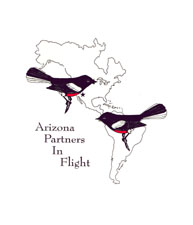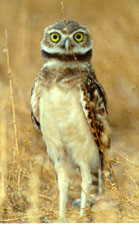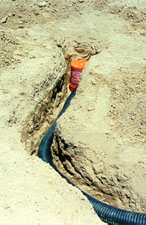

 Photo
by Greg Clark
Photo
by Greg ClarkBurrowing Owl Artificial Nest Box Project
An Arizona Partners in Flight Habitat Substitution Project


 Photo
by Greg Clark
Photo
by Greg Clark
|
Project and Problem Summary: In the Eastern United States artificial nest boxes were built by volunteers and organizations to try to increase the populations of Bluebirds. The nest boxes replaced natural tree cavities that had been lost when the trees were lost. The effort was a huge success. The same thing can be done for Burrowing Owls, except the cavity is in the ground. If someone chops down all the trees in a forest, everyone understands that this will have a devastating effect on the wildlife. It is not as obvious that as much damage can be done to some species when holes in the ground are covered up. Efforts are under way to figure out where replacement burrows can be installed that will have the most benefit. Some burrows have been installed to replace burrows lost nearby to development, and much of the following material shows this work. However, these burrows are part of rescue work done in conjunction with Wild At Heart (a rehabilitation group in Cave Creek, Arizona). As important to the owl as rescue work is, it is different from figuring out where to install burrows to attract new populations of owls. Phase I of the project is about finding landowners who will provide burrow sites and learning which sites the Burrowing Owl prefers. We need your help finding sites and installing burrows. Surprisingly, this is not some problem to be solved in the "wilderness." The burrows need to be installed in urban areas where development is already completed . That means all around where people live. We need niche areas, like around commercial buildings or urban greenbelts, where the burrows can be installed away from trees and buildings but near possible food sources (mice and insects). There is still time to reverse the steep decline in the Burrowing Owl population, with your help. If you live in the greater Phoenix area, you can help us directly with this project. Because Arizona is the winter home for many owls that breed in Canada and the states north of Arizona, this project can affect the entire owl population of North America. We need burrow sites and help digging the holes. If you can help, or if you would like more information about how to help the owls in your area, contact Greg Clark at: manually type in the e-mail address b i r d i n f o @ m i r ro r - p o l e . com without spaces Also you can call Wild At Heart at 480-595-5047 for more information or to report an owl in trouble. |
The Burrowing Owl is Federally protected by U.S. Laws pertaining to Migratory Species. If you are contemplating an operation that could destroy a burrow, or cover up a burrow with dirt, possibly killing the owl inside, this is against the law. You can find out more about this where the list of protected birds is given on a U.S. Fish and Wildlife website:
http://migratorybirds.fws.gov/intrnltr/treatlaw.html#mbta
http://migratorybirds.fws.gov/intrnltr/mbta/mbtandx.html#alpha1 The list of protected birds can be found here, look under Owls to find Burrowing Owl.
More about the Burrowing Owl and artificial burrows:
One of North America's most engaging and beneficial birds, the Burrowing Owl is experiencing a decline in population as nest sites are lost to development. Unlike birds that nest in trees, the Burrowing Owl is dependent on a ground burrow dug by other animals. If the animals are displaced, and the burrows covered over, then the Burrowing Owls must also leave. Eventually, the population of owls begins to fall merely because of a lack of suitable ground nest sites. Unlike other owls that are typically most active at night, the Burrowing Owl is most active during the day. Engaging to watch, the owl also makes a wide range of intriguing sounds. Typically perched near its burrow during the day, the owl is often easy to spot and is a great educational resource for anyone interested in learning more about wildlife. Surprisingly, this owl often selects natural nest sites on bare ground in open areas with little surrounding vegetation. Many commercial and city-maintained areas in the greater Phoenix area would be ideal for artificial burrows because the open spaces around the buildings are often bare ground, free of grass and large trees. The idea that these types of spaces could be used for habitat substitution for the Burrowing Owl has led to this project and we need to find interested groups that can help us make new home sites for this owl. Working in conjunction with Wild at Heart, based in Cave Creek, Arizona, some artificial burrows have been provided to replace burrows that are being lost due to development. This work shows what is involved to install a burrow.
 Here
a volunteer gets ready to check the depth of the hole
and tunnel dug by a backhoe to see if the orange bucket and black
hose will fit properly. A typical hole is dug 4 feet deep so that
the average temperature in the burrow will be around 75 degrees
F. The developer worked with us both to provide a site for the
burrows in Peoria and to carry out the earth excavation, so that
very little manual labor was involved. Burrows can also be dug
by hand.
Here
a volunteer gets ready to check the depth of the hole
and tunnel dug by a backhoe to see if the orange bucket and black
hose will fit properly. A typical hole is dug 4 feet deep so that
the average temperature in the burrow will be around 75 degrees
F. The developer worked with us both to provide a site for the
burrows in Peoria and to carry out the earth excavation, so that
very little manual labor was involved. Burrows can also be dug
by hand.
 An underground
burrow is built using a plastic bucket for the burrow and 4"
flexible irrigation hose for the tunnel from the ground to the
burrow. The orange bucket costs about 3 dollars at Home Depot
and the 4" hose costs about 6 dollars for the 12 feet required
for a typical burrow. This means that materials are less than
10 dollars per burrow. For protection from dogs, in locations
where the burrows are not in protected areas (like in fenced-off
areas) a rigid PVC pipe must be used to protect the burrow entrance.
See the special link for hardening a burrow against dog attacks.
Holes must be provided in the bucket and hose to allow water to
escape into the ground, the flexible hose can be purchased with
perforations. In addition, the hose must make a double turn between
the burrow and the surface to simulate natural burrows. The simple
diagram above only shows the tube bending toward the surface,
but it also needs to bend horizontally 90 degrees. The photograph
below shows the bucket and tubing in place before being buried.
The section from the buurow to the bend should be at a 4-foot
depth. If you want to proceed on your own, contact us for more
detailed information.
An underground
burrow is built using a plastic bucket for the burrow and 4"
flexible irrigation hose for the tunnel from the ground to the
burrow. The orange bucket costs about 3 dollars at Home Depot
and the 4" hose costs about 6 dollars for the 12 feet required
for a typical burrow. This means that materials are less than
10 dollars per burrow. For protection from dogs, in locations
where the burrows are not in protected areas (like in fenced-off
areas) a rigid PVC pipe must be used to protect the burrow entrance.
See the special link for hardening a burrow against dog attacks.
Holes must be provided in the bucket and hose to allow water to
escape into the ground, the flexible hose can be purchased with
perforations. In addition, the hose must make a double turn between
the burrow and the surface to simulate natural burrows. The simple
diagram above only shows the tube bending toward the surface,
but it also needs to bend horizontally 90 degrees. The photograph
below shows the bucket and tubing in place before being buried.
The section from the buurow to the bend should be at a 4-foot
depth. If you want to proceed on your own, contact us for more
detailed information.
 This
is an example of a burrow dug by hand, rather than by backhoe.
There must be at least two feet of dirt on top of the over-turned
bucket. The photo shows the bucket and hose before being buried.
This
is an example of a burrow dug by hand, rather than by backhoe.
There must be at least two feet of dirt on top of the over-turned
bucket. The photo shows the bucket and hose before being buried.
This burrow in Chandler became the home for owls that were displaced for a 200-home development project.
Once an area is slated for development where there are Burrowing Owls present, someone must carefully investigate all the burrows to make sure no owls are inside and then carefully collapse the burrow so no owl can return to be trapped inside. One of the first things that happens at a development site is land preparation that moves all the surface dirt around. Sadly, this can trap the owls in the burrow. Investigating these burrows is where Wild At Heart comes in. Holders of both Arizona Game and Fish and U.S. Fish and Wildlife permits for doing this type of work, Wild At Heart can investigate and safely collapse the burrows and, where necessary, relocate the owls to new sites. Follow the next link to see some burrow sites in Chandler, Arizona where the burrows had to be collapsed. Fortunately, a nearby homeowner offered to help us with our artificial burrow project and so the owls were able to relocate only a few hundred feet from where they were born, in habitat much like where they lived before.
Additional Burrow Construction Information and Protection Needed for Domestic Dog Attacks
Arizona Burrowing Owl Distribution
More Burrow Sites and Owl Photos
Red_Hawk Power_Plant_Release_Site New June, 2002. See where 25 Burrowing Owls were released.
Paseo Verde School New May, 2003. See the owls in one of the burrows using infrared video cameras.
Copyright Greg Clark, 2001